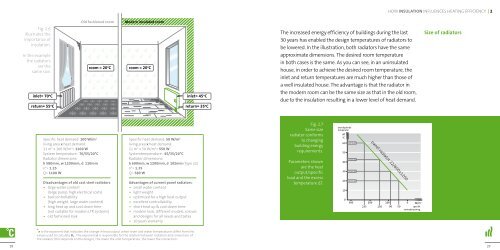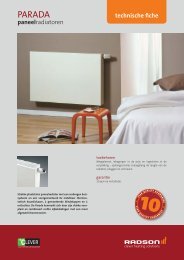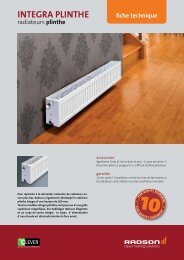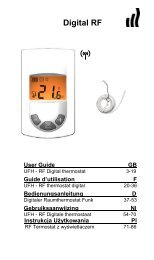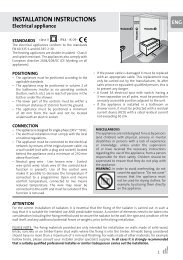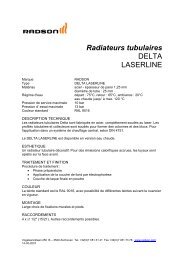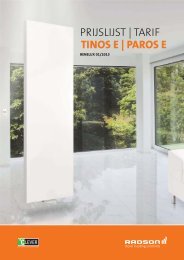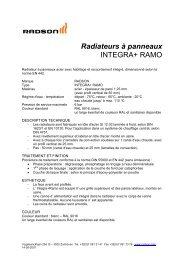Download - Purmo Radson
Download - Purmo Radson
Download - Purmo Radson
You also want an ePaper? Increase the reach of your titles
YUMPU automatically turns print PDFs into web optimized ePapers that Google loves.
HOW INSULATION INFLUENCES HEATING EFFICIENCY | 2<br />
Old fashioned room<br />
Modern insulated room<br />
Fig. 2.6<br />
Illustrates the<br />
importance of<br />
insulation.<br />
In the example<br />
the radiators<br />
are the<br />
same size.<br />
inlet= 70 o C<br />
return= 55 o C<br />
room = 20 o C<br />
room = 20 o C<br />
inlet= 45 o C<br />
return= 35 o C<br />
The increased energy efficiency of buildings during the last<br />
30 years has enabled the design temperatures of radiators to<br />
be lowered. In the illustration, both radiators have the same<br />
approximate dimensions. The desired room temperature<br />
in both cases is the same. As you can see, in an uninsulated<br />
house, in order to achieve the desired room temperature, the<br />
inlet and return temperatures are much higher than those of<br />
a well insulated house. The advantage is that the radiator in<br />
the modern room can be the same size as that in the old room,<br />
due to the insulation resulting in a lower level of heat demand.<br />
Size of radiators<br />
Specific heat demand: 100 W/m 2<br />
living area x heat demand:<br />
11 m 2 x 100 W/m 2 = 1100 W<br />
System temperature: 70/55/20°C<br />
Radiator dimensions:<br />
h 580mm, w 1200mm, d 110mm<br />
n*= 1.25<br />
Q= 1100 W<br />
Disadvantages of old cast steel radiators:<br />
• large water content<br />
(large pump, high electrical costs)<br />
• bad controllability<br />
(high weight, large water content)<br />
• long heat up and cool down time<br />
(not suitable for modern LTR systems)<br />
• old fashioned look<br />
Specific heat demand: 50 W/m 2<br />
living area x heat demand:<br />
11 m 2 x 50 W/m 2 = 550 W<br />
Systemtemperature: 45/35/20°C<br />
Radiator dimensions:<br />
h 600mm, w 1200mm, d 102mm (Type 22)<br />
n*= 1.35<br />
Q= 589 W<br />
Advantages of current panel radiators:<br />
• small water content<br />
• light weight<br />
• optimized for a high heat output<br />
• excellent controllability<br />
• short heat up & cool down time<br />
• modern look, different models, colours<br />
and designs for all needs and tastes<br />
• 10 years warranty<br />
Fig. 2.7<br />
Same size<br />
radiator conforms<br />
to changing<br />
building energy<br />
requirements.<br />
Parameters shown<br />
are the heat<br />
output/specific<br />
load and the excess<br />
temperature ΔT.<br />
overskydende<br />
temperatur<br />
AT<br />
o C<br />
60<br />
50<br />
40<br />
30<br />
20<br />
10<br />
90/70/20<br />
70/55/20<br />
55/45/20<br />
45/35/20<br />
panel radiator 22/600x1200<br />
0<br />
300 200<br />
100<br />
0 W/m 2<br />
235 150 90 50 specifik<br />
varmebelastning<br />
*n is the exponent that indicates the change in heat output when room and water temperatures differ from the<br />
values used to calculate θ 0. The exponent n is responsible for the relation between radiation and convection of<br />
the radiator (this depends on the design). The lower the inlet temperature, the lower the convection.<br />
28<br />
29


